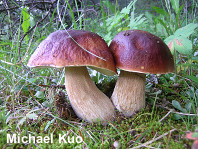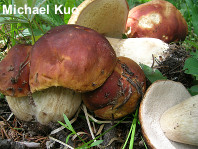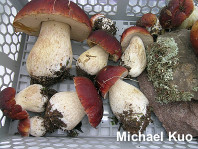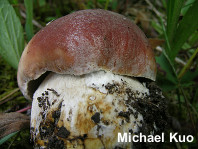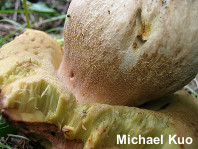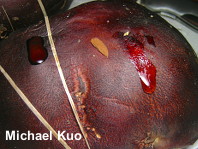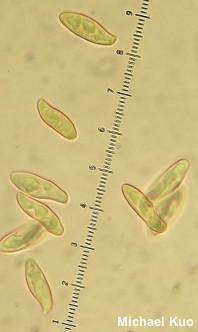| Major Groups > Boletes > Edulis Group > Boletus rubriceps |

|
Boletus rubriceps [ Basidiomycota > Boletales > Boletaceae > Boletus . . . ] by Michael Kuo This is a gorgeous and impressive mushroom, found under spruces at high elevations in the Rocky Mountains in late summer and early fall. It is a large bolete with a reddish to reddish brown, greasy-when-fresh cap surface. When young, the pore surface is whitish and "stuffed" in appearance—and the stem features fine-meshed reticulation. Fist-sized buttons can often be found barely emerging from the duff—and at maturity the cap can be nearly as wide as a dinner plate. Amanita muscaria is often fruiting nearby, as well as Sarcodon imbricatus. Boletus rubriceps is a member of the North American Boletus edulis group, and I think it is closer to the "true" Boletus edulis of Europe than most of its North American counterparts—or, more precisely, it seems virtually identical to the reddish-capped version of Boletus edulis I have collected many times under Scots pine (Pinus sylvestris) in Finland, which European mycologists often call "Boletus pinophilus"—though they often concede it "may indeed be nothing more than a variety of B. edulis" (Breitenbach & Kränzlin, 1991). Description: Ecology: Mycorrhizal with Engelmann spruce, and perhaps with other spruces and with firs; growing alone, scattered, or gregariously; summer and fall, in monsoon season; southern Rocky Mountains. The illustrated and described collections are from Colorado. Cap: 8–22 cm at maturity; convex in the button stage, becoming broadly convex to nearly flat; greasy to tacky; bald; often shallowly wrinkled in places; brownish red to reddish brown; sometimes with a whitish bloom when young. Pore Surface: White to whitish at first, becoming yellowish to brownish yellow and eventually olive; not bruising; pores "stuffed" at first; with 2–4 circular pores per mm at maturity; tubes to 2 cm deep. Stem: 8–18 cm long; 3–8 cm thick; swollen and club-shaped when young, becoming club-shaped or equal; finely whitish-reticulate over at least the upper portion; whitish or pale brownish; basal mycelium white. Flesh: White; solid; unchanging when sliced, or staining slightly pinkish. Odor and Taste: Taste nutty; odor not distinctive. Chemical Reactions: KOH red to orange or orangish on cap; negative on flesh. Ammonia black to dark red on cap; negative on flesh. Spore Print: Olive to brownish. Microscopic Features: Spores 12–20 x 4–5.5 µm; fusiform to subfusiform; smooth; yellowish in KOH. Basidia 4-sterigmate. Hymenial cystidia to about 30 x 5 µm; lageniform; smooth; thin-walled; hyaline in KOH; rare and scarcely projecting. Pileipellis a collapsing trichoderm; golden in KOH; elements 5–7.5 µm wide, smooth, frequently septate; terminal cells subclavate, cylindric with rounded apices, or occasionally slightly constricted. REFERENCES: D. Arora & J. L. Frank, 2014. (States, 1990; Evenson, 1997; Evenson, 2015; Cripps, Evenson & Kuo, 2016.) Herb. Kuo 07280606, 08150719. Herb. DBG RMNP 2008-249, ROMO 212 5023-30. Note: The species featured here appeared previously at this website (from September 2010 to November 2016) as "Boletus cf. pinophilus." This site contains no information about the edibility or toxicity of mushrooms. |
© MushroomExpert.Com |
|
Cite this page as: Kuo, M. (2016, November). Boletus rubriceps. Retrieved from the MushroomExpert.Com Web site: http://www.mushroomexpert.com/boletus_rubriceps.html |
